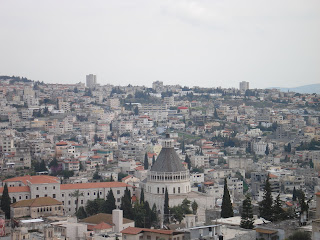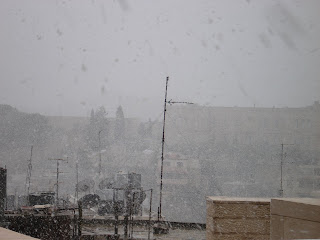
We are staying two nights at the Lutheran Christmas Church in Bethlehem. It is a wonderful facility that houses not only a church, but a school (K-12) with 280 students, a health & wellness Center, and a college. The pastor, Mitri Raheb, is also the author of the book Bethlehem Under Siege, a book I read on the flight from Phoenix to London to Cairo. Mitri gently takes issue with those who are surprised that he is a Palestinian Christian. He told us, “I was born across the street from the Church of the Nativity. One of my great, great, great etc… grandmothers babysat Jesus.” Mitri spoke to our group for an hour and a half. He told us, “Here, you are going to see ministry in action.” And we did indeed! We visited the school and heard the inspiring vision of the principal. The school does not apologize for teaching Christian values and yet 60% of the students are from Moslem families. When asked about the possibility of Moslems converting to Christianity, Dr. Raheb responded, “It is forbidden to make Muslims Christian, but if Muslim students discover what Christ is really like, you never know what these children will become...” The vision of this ministry in one sentence is based on John 10:10, “that we might have life abundantly”. Dr Raheb said, “Military occupation and unemployment tells us we cannot have abundant life. We want to continue the mission of Christ in this place.”
The health and wellness center is reaching about 10,000 people a year. Dr. Raheb told us, “You cannot imagine how many people are traumatized in this city.” You see, to get to a hospital in nearby Jerusalem a Palestinian must be granted a permit from the Israeli government. Permits are extremely difficult to get. Many people suffer and many die simply because they live in Bethlehem and have no access to health care. The health center at Lutheran Christmas Church has 185 elderly people attending the weekly wellness program. The coordinator is Baptist and is basically a perish nurse. The center focuses on general preventative medicine, community health awareness and psychological health issues.
Dr. Raheb said, “The most important thing we do here is provide hope in a land of despair.” Make no mistake about it; Christians are making a difference in this land.











 In front of Cave #4 at Qumran
In front of Cave #4 at Qumran



















 Mozaic in Sepphors
Mozaic in Sepphors

 Lunch: St. Peter's Fish, tilapia
Lunch: St. Peter's Fish, tilapia



 Church of the Nativity
Church of the Nativity 


















